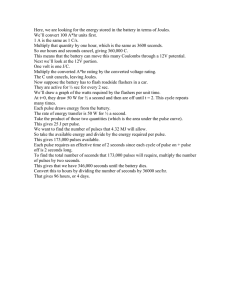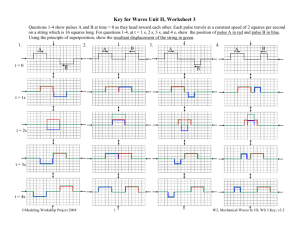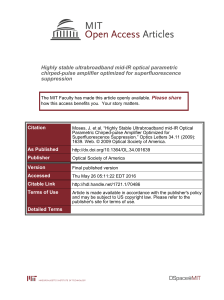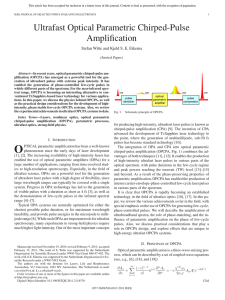High-power, few-cycle, phase-stabilized 2.2-m optical parametric chirped pulse amplifier Please share
advertisement
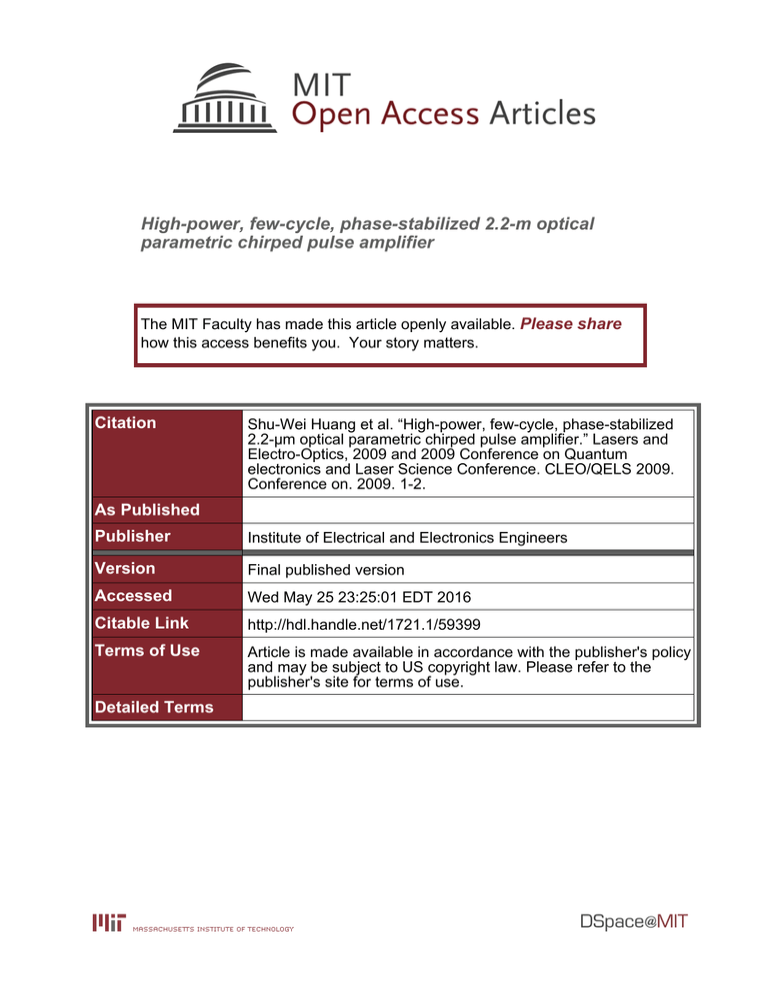
High-power, few-cycle, phase-stabilized 2.2-m optical parametric chirped pulse amplifier The MIT Faculty has made this article openly available. Please share how this access benefits you. Your story matters. Citation Shu-Wei Huang et al. “High-power, few-cycle, phase-stabilized 2.2-µm optical parametric chirped pulse amplifier.” Lasers and Electro-Optics, 2009 and 2009 Conference on Quantum electronics and Laser Science Conference. CLEO/QELS 2009. Conference on. 2009. 1-2. As Published Publisher Institute of Electrical and Electronics Engineers Version Final published version Accessed Wed May 25 23:25:01 EDT 2016 Citable Link http://hdl.handle.net/1721.1/59399 Terms of Use Article is made available in accordance with the publisher's policy and may be subject to US copyright law. Please refer to the publisher's site for terms of use. Detailed Terms © 2009 OSA/CLEO/IQEC 2009 a1821_1.pdf CWL4.pdf CWL4.pdf High-Power, Few-Cycle, Phase-Stabilized 2.2-µm Optical Parametric Chirped Pulse Amplifier Shu-Wei Huang1, Jeffrey Moses1, Kyung-Han Hong1, Edilson L. Falcão-Filho1, Andrew Benedick1, Jeremy Bolger2, Benjamin Eggleton2, and Franz X. Kärtner1 1 Department of Electrical Engineering and Computer Science and Research Laboratory of Electronics, Massachusetts Institute of Technology, Cambridge, MA 02139, USA 2 CUDOS ARC Centre of Excellence School of Physics, University of Sydney, Sydney, Australia klkla@mit.edu Abstract: We demonstrate a high-peak-power, 1-kHz, 2.2-μm OPCPA for long-wavelengthdriven high harmonic generation that produces 9-GW, 3-optical-cycle, CEP-stabilized pulses, allowing tunneling-ionization-threshold intensity with low Guoy phase shift. ©2009 Optical Society of America OCIS codes: (190.4970) Parametric oscillators and amplifiers; (320.7110) Ultrafast nonlinear optics Since the prediction of high-yield soft X-ray photon generation through high harmonic generation (HHG) with longwavelength drive pulses [1, 2], the development of high-power, few-cycle, carrier-envelope phase- (CEP-) stabilized sources in the infrared has attracted great attention. Due to the unavailability of broadband laser gain media in this wavelength range, this technology has widely relied upon some combination of parametric frequency conversion and nonlinear spectral broadening, using a broadband Ti:sapphire amplifier as a front end. Such techniques work well but are ultimately limited in average power by the Ti:sapphire amplifier, and the external compression technique based on either hollow-core fiber or filamentation in gas as a final step is inherently challenging to scale to the multi-mJ energy level [3, 4]. In contrast, ultra-broadband optical parametric chirped pulse amplification (OPCPA) provides a clear route to overcoming this limitation by direct amplification of a few-cycle seed pulse [5-8]. There is a distinct advantage to building an OPCPA system for driving HHG centered around 2 μm, as opposed to other mid-IR wavelengths: high-average-power ultra-broadband amplification is feasible because it is degenerate with the highest average power pump sources available to date [9, 10] and the zero-dispersion wavelength of standard nonlinear crystals such as lithium niobate and lithium tantalate is around 2 μm. In this paper, we report the development of a 2.2-μm OPCPA which generates 9-GW, 3-optical-cycle pulses (200 μJ, 23 fs) at 1 kHz. It is, to date, the highest peak power for few-cycle pulses at 2-μm wavelength obtained by direct parametric amplification. Implementing several methods of suppressing superfluorescence noise introduced in our previous work [8], our results verify the prediction of suitable noise suppression at the multi-100-μJ level, surpassing the 80-μJ level demonstrated previously [7]. Scaling to multi-100-μJ energy is an important and necessary step for efficient HHG: below 100 μJ, even few-cycle pulses require tight focal volumes with high Guoy phase shift (which scales with the inverse of the beam waist squared), impeding good HHG phase matching. With 200 μJ and a loose focus of ~50 μm waist, allowing reasonable phase matching, the intensity of our source exceeds 1014 W/cm2 and we have clearly observed a ~2-mm-long plasma column in air. Our current results suggest that our OPCPA design can be scaled to the multi-mJ energy level while maintaining low noise, which will allow absorption-limited HHG. Such steps are valuable to the pursuit of the next generation of high-flux, HHG-based soft X-ray sources. The schematic of our OPCPA system is shown in Fig. 1. An octave-spanning Ti:sapphire oscillator is used to generate passively CEP-stabilized broadband seed pulses by intra-pulse DFG. We have developed a Nd:YLF chirped pulse amplifier (CPA) as a pump source, which consists of a chirped fiber Bragg grating (CFBG) stretcher, a regenerative amplifier followed by two multi-pass slab amplifiers, and a diffraction grating compressor. It is seeded YDFA Nd:YLF regen amp 120ps, 1 mJ @1kHz 2 Nd:YLF-MPS amp 120ps, 7mJ @1kHz CFBG stretcher YDFA DFG 1 pJ OPA 1 Si 12 ps, 4.5 mJ 140µJ 600µJ 3.2 mJ MgO:PPLN Ti:Sa oscillator OPA 2 AOPDF MgO:PPSLT OPA 3 MgO:PPSLT Figure 1. Schematic of the OPCPA system 978-1-55752-869-8/09/$25.00 ©2009 IEEE 220 µJ, 23 fs suprasil © 2009 OSA/CLEO/IQEC 2009 a1821_1.pdf CWL4.pdf CWL4.pdf by the 1047-nm component of the residual Ti:sapphire oscillator spectrum and provides 12-ps, 4-mJ pump pulses for the OPCPA stages. The OPCPA seed pulse from DFG is first stretched by a bulk silicon block to 5 ps and preamplified in OPA1 to 1.5 μJ. The pre-amplified pulse is then further stretched to 9.5 ps by an infrared acousto-optic programmable dispersive filter (AOPDF: DAZZLER, Fastlite), allowing for simultaneous optimization of energy extraction, amplification bandwidth, and signal-to-noise ratio in the power amplifier stage [11]. Losses from the AOPDF (~90%) and spatial filters are compensated by a second preamplifier, OPA2. Finally, the pulse is amplified to 220 μJ in OPA3 and compressed in a broadband anti-reflection coated quartz glass block (Suprasil 300), which introduces ~10% loss. The AOPDF also compensates for the residual dispersion from the bulk stretcher/compressor unit, allowing the pulse duration to reach near transform limit after the bulk compressor. Fig. 2 shows the amplified spectrum (a) and the corresponding interferometric autocorrelation trace (b) of the OPCPA system. The pulse is compressed nearly to its transform limit, i.e., 23 fs, or 3 cycles in FWHM. Due to the low available seed energy from the DFG process, superfluorescence suppression plays a key role in the pulse energy scalability of the OPCPA. Four design features are implemented in our setup to suppress superfluorescence. First, our stretcher/compressor scheme maximizes the initial signal-to-noise ratio by avoiding placement of the lossy AOPDF before the amplifier chain. Second, we implement both hard and soft apertures after OPA1 to filter out superfluorescence-dominated high-order spatial modes. An aperture also eliminates spatial chirp, a side-effect of the AOPDF. Third, we use a seed with a spectrum spanning 1.6-2.5 μm, which fully covers the amplifier gain bandwidth. Fourth, we have carefully tailored the signal pulse durations in each amplification stage to fully seed the temporal gain profiles of the amplifiers while maintaining high conversion efficiency and wide signal bandwidth. We observe a clean and stable amplified signal spectrum as well as spatial profile. The energy fluctuation of amplified pulses is as low as 1.5% (rms). We predict the system should be scalable to the multi-mJ level without the superfluorescence overtaking the signal. 8 Intensity (a.u.) Intensity (a.u.) 1.0 0.5 0.0 1800 2100 2400 wavelength (nm) 6 4 2 0 -50 0 50 delay (fs) 0 2 4 6 time (s) 8 10 Figure 2. (a) Amplified spectrum, measuring 500-nm FWHM bandwidth. (b) IAC of the compressed pulse, measuring 23 fs (3 cycles). (c) f-3f spectral interferogram, measuring 150 mrad rms CEP fluctuation. The CEP stability is characterized using an f-to-3f spectral interferometer with a sapphire plate and a BBO crystal [7]. Fig. 2(c) shows that the rms phase fluctuation is ~150 mrad over 10 s, where the residual phase excursion at time = ~2 s is attributed to the amplitude–phase noise coupling in the f-to-3f interferometer while any significant drift is not observed during 10 s. In conclusion, we have demonstrated a 9-GW, 3-optical-cycle (200 μJ, 23 fs), phase-stabilized 2.2-μm OPCPA system with suppressed superfluorescence. Scaling up to multi-100-μJ is an important and necessary step for efficient HHG because tight focusing to a few tens of microns is not required. Our current results suggest that scaling should be possible to the multi-mJ level, which will allow absorption-limited HHG. [1] [2] [3] [4] [5] [6] [7] [8] [9] [10] [11] B. Shan and Z. H. Chang, "Dramatic extension of the high-order harmonic cutoff by using a long-wavelength driving field," Phys. Rev. A, 65, 011804 (2002). A. Gordon and F. X. Kartner, "Scaling of keV HHG photon yield with drive wavelength," Opt. Express, 13, 2941 (2005). S. Bohman, et al., "Generation of 5 fs, 0.5 TW pulses focusable to relativistic intensities at 1 kHz," Opt. Express, 16, 10684 (2008). C. P. Hauri, et al., "Intense self-compressed, self-phase-stabilized few-cycle pulses at 2 mu m from an optical filament," Opt. Lett., 32, 868 (2007). F. Tavella, et al., "90 mJ parametric chirped pulse amplification of 10 fs pulses," Opt. Express, 14, 12822 (2006). D. Kraemer, et al., "High-power femtosecond infrared laser source based on noncollinear optical parametric chirped pulse amplification," J. Opt. Soc. Am B, 24, 813 (2007). T. Fuji, et al., "Parametric amplification of few-cycle carrier-envelope phase-stable pulses at 2.1 micron," Opt. Lett., 31, 1103 (2006). J. Moses, et al., "Optimized 2-micron Optical Parametric Chirped Pulse Amplifier for High Harmonic Generation," in Ultrafast Phenomena, Stresa, Italy, 2008, p. paper FrI1p2. K.-H. Hong, et al, "Generation of 287 W, 5.5 ps pulses at 78 MHz repetition rate from a cryogenically cooled Yb:YAG amplifier seeded by a fiber chirped-pulse amplification system," Opt. Lett., 33, 2473 (2008). L. McDonagh, et al., "111 W, 110 MHz repetition-rate, passively mode-locked TEM00 Nd : YVO4 master oscillator power amplifier pumped at 888 nm," Opt. Lett., 32, 1259, (2007). J. Moses, et al., "Temporal Optimization of Ultrabroadband Optical Parametric Chirped Pulse Amplification.," in Ultrafast Phenomena, Stresa, Italy, 2008, p. paper Tue51.8.
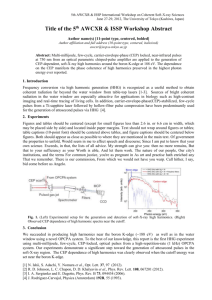
![[ ] [ ] ( )](http://s2.studylib.net/store/data/011910597_1-a3eef2b7e8a588bc8a51e394ff0b5e0e-300x300.png)


